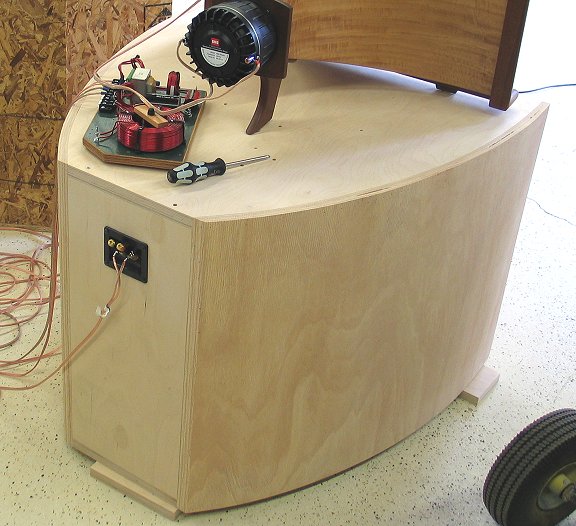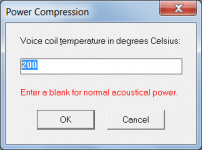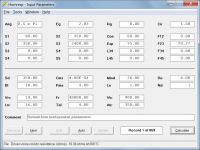this is, what we want to know
Eg=90V and Rg=half of Re=T of 170°C
Hi jogi59,
Just to clarify, are you saying:
1. That you would like the input parameter to be Eg rather than Pmax?
2. That you would like to know the value of Re at the specified temperature?
For example, if Re is 8 ohms at the standard reference temperature of 20 deg C, you would like to know that the voice coil resistance becomes 12.82 ohms at 170 deg C?
Kind regards,
David
@ David McBean,
First of all want to say I make a deep bow for sharing Hornresp with us!
It's seldom that people make such great software and share it for free.
I like that attitude and therefor I want to do something back in return.
I have converted the included helpfile from a txt into a doc format because personaly I find that easier to read and maybe others will find that too.
If you are interested I can send you this file in doc, docx or pdf format.
First of all want to say I make a deep bow for sharing Hornresp with us!
It's seldom that people make such great software and share it for free.
I like that attitude and therefor I want to do something back in return.
I have converted the included helpfile from a txt into a doc format because personaly I find that easier to read and maybe others will find that too.
If you are interested I can send you this file in doc, docx or pdf format.
Hi oiraM,
Thanks .
.
The Hornresp Help file is just a Word document file with a .hlp extension .
.
The easiest way to convert the Hornresp.hlp file to a document file is simply to change the file extension back from .hlp to .doc.
Alternatively, select File > Export from the Hornresp Help file menu and then open the exported text file in Notepad or Word.
Thanks again, but that is not necessary - my master reference copy of the Hornresp Help file is already in .doc format .
.
Kind regards,
David
First of all want to say I make a deep bow for sharing Hornresp with us!
It's seldom that people make such great software and share it for free.
Thanks
I have converted the included helpfile from a txt into a doc format because personaly I find that easier to read and maybe others will find that too.
The Hornresp Help file is just a Word document file with a .hlp extension
The easiest way to convert the Hornresp.hlp file to a document file is simply to change the file extension back from .hlp to .doc.
Alternatively, select File > Export from the Hornresp Help file menu and then open the exported text file in Notepad or Word.
If you are interested I can send you this file in doc, docx or pdf format.
Thanks again, but that is not necessary - my master reference copy of the Hornresp Help file is already in .doc format
Kind regards,
David
Hornresp Update 3630-141112
Hi Everyone,
CHANGE 1
The Power Compression tool inputs have been changed from Pmax and Tmax to Eg and Tmax.
Attachment 1 shows the new Tmax input form. Eg is entered on the main input parameters screen.
CHANGE 2
When the Power Compression tool is used, the increased driver voice coil resistance due to heating is now shown in the status bar panel at the bottom of the input parameters window, when the mouse pointer is moved over the Re input box.
Attachment 2 shows the driver voice coil resistance increasing from the given value of Re to 10.36 ohms at the specified temperature of 200 deg C.
My thanks to those who provided feedback on the above changes.
Kind regards,
David
Hi Everyone,
CHANGE 1
The Power Compression tool inputs have been changed from Pmax and Tmax to Eg and Tmax.
Attachment 1 shows the new Tmax input form. Eg is entered on the main input parameters screen.
CHANGE 2
When the Power Compression tool is used, the increased driver voice coil resistance due to heating is now shown in the status bar panel at the bottom of the input parameters window, when the mouse pointer is moved over the Re input box.
Attachment 2 shows the driver voice coil resistance increasing from the given value of Re to 10.36 ohms at the specified temperature of 200 deg C.
My thanks to those who provided feedback on the above changes.
Kind regards,
David
Attachments
Hello David.
I've been playing with the new toys.
Interesting.
I like them.
Thanks again for your diligence.
Hi Mark,
The Power Compression tool input has now been changed from Pmax to Eg, as suggested.
Note that power compression can still be determined using Pmax rather than Eg, if required. The procedure is as follows:
1. Calculate power compression at the required temperature.
2. Change the value of Re to the figure shown in the status bar panel.
3. Calculate maximum SPL with Xmax set to 99.9.
Kind regards,
David
@ David McBean
Seems we can have our cake, & eat it too
Thanx for including the options
Note that power compression can still be determined using Pmax rather than Eg, if required. The procedure is as follows:
Seems we can have our cake, & eat it too
Thanx for including the options
what a wonderful thread I've been dying to see! I hope I can get some help about Hornresp here about a folded horn I'm building. can I check inarticulate parameters here? 
I want to calculate/tweak this folded horn in Hornresp. where should I start?
it might look something like this after construction:

I want to calculate/tweak this folded horn in Hornresp. where should I start?
An externally hosted image should be here but it was not working when we last tested it.
it might look something like this after construction:

An externally hosted image should be here but it was not working when we last tested it.
Last edited:
I designed that.
You are pretty close.
If you want some help P.M. me.
Uh thanks. I sent you a pm and I'm anxious for your reply
actually the idea of a curved La scala came to my mind back in 2011 but never spent some time on it, what you see in previous post is the result of my six months long tweaking one eye looking at Stock La Scala and one eye to Vittoras
thanks,
Thanx for including the options
Hi Zero D,
Thanks for prompting me to do so
Kind regards,
David
Uh thanks. I sent you a pm and I'm anxious for your reply
actually the idea of a curved La scala came to my mind back in 2011 but never spent some time on it, what you see in previous post is the result of my six months long tweaking one eye looking at Stock La Scala and one eye to Vittoras
thanks,
One eye on each!
Now that will make you cross eyed!
@ David
This new feature can and should be a teaching tool. And an interesting one at that.
I'll keep digging into the mathematics of the heating process to see if anyone has cracked that tough little nut.
The primary angst on my side was that the simulations are so close to real in many cases that throwing in an estimate was a bit of folly.
But I must admit it is an interesting little addition. And there are quite a few drivers that have been power compression tested on data-bass.com to do real world comparisons with.
Thanks for doing the work to get this latest featuring running.
This new feature can and should be a teaching tool. And an interesting one at that.
I'll keep digging into the mathematics of the heating process to see if anyone has cracked that tough little nut.
The primary angst on my side was that the simulations are so close to real in many cases that throwing in an estimate was a bit of folly.
But I must admit it is an interesting little addition. And there are quite a few drivers that have been power compression tested on data-bass.com to do real world comparisons with.
Thanks for doing the work to get this latest featuring running.
Hi Mark,
The Power Compression tool certainly appears to be proving useful in demonstrating the overall effect of voice coil heating, even if the results are not precisely accurate.
Good luck with that one .
.
I suspect that any reasonably accurate thermal model would require the driver construction to be specified in far more detail than any manufacturer would be prepared to release, and also need very advanced finite element analysis software to do the simulations. Way beyond the scope of Hornresp .
.
You're welcome .
.
Kind regards,
David
This new feature can and should be a teaching tool. And an interesting one at that.
The Power Compression tool certainly appears to be proving useful in demonstrating the overall effect of voice coil heating, even if the results are not precisely accurate.
I'll keep digging into the mathematics of the heating process to see if anyone has cracked that tough little nut.
Good luck with that one
I suspect that any reasonably accurate thermal model would require the driver construction to be specified in far more detail than any manufacturer would be prepared to release, and also need very advanced finite element analysis software to do the simulations. Way beyond the scope of Hornresp
Thanks for doing the work to get this latest featuring running.
You're welcome
Kind regards,
David
The power compression model seems to only take account of the increased resistance due to the temperature rise.
Is there any audible, or measurable, effect due to added distortion when the temperature cycles during each half cycle of the peak signal?
i.e. dynamic changes in the VC resistance will give distortion of the output.
This would be roughly equivalent to "soft clipping" of the lower frequencies (with respect to the time constant of the VC).
Is there any audible, or measurable, effect due to added distortion when the temperature cycles during each half cycle of the peak signal?
i.e. dynamic changes in the VC resistance will give distortion of the output.
This would be roughly equivalent to "soft clipping" of the lower frequencies (with respect to the time constant of the VC).
A very good explanation of PC here 
Understanding Power Compression
Of those 5 parameters, there are three that can change once power (rather, more power) is applied; they are: Re, BL, and Cms. Now we will review the cause and effects for each one.
Understanding Power Compression - Realm of Excursion
So for audibility.
Your low end gets a great deal more flabby.
The crossovers are out to lunch. And that will change things the most. All your calculations for crossover work are for small signal measurements. Not the levels nearing power compression.
All the gloom and doom is for naught. Most listening is done well within the linear regions of almost all drivers.
Except in the low end if you are into making walls turn into jelly.
I have done that on an occasion or two over the years.
Although having a horn loaded subwoofer capable of reproducing 14 hertz at concert levels is a little bit of fun when listening to Jean Guillou or Virgil Fox. About the only gentlemen I know of that have anything at serious levels down that low.
Your low end gets a great deal more flabby.
The crossovers are out to lunch. And that will change things the most. All your calculations for crossover work are for small signal measurements. Not the levels nearing power compression.
All the gloom and doom is for naught. Most listening is done well within the linear regions of almost all drivers.
Except in the low end if you are into making walls turn into jelly.
I have done that on an occasion or two over the years.
Although having a horn loaded subwoofer capable of reproducing 14 hertz at concert levels is a little bit of fun when listening to Jean Guillou or Virgil Fox. About the only gentlemen I know of that have anything at serious levels down that low.
I'm a novice with Hornresp, but I think after several hours I was able to figure out most of my questions by myself.
Nevertheless there are still some things that are not clear to me.
Let's asume I would want to build two equal units into a horn enclosure.
Each unit has an effective surface area (Sd) 55cm².
Next I take this in account in Hornresp (Nd = 2S).
1. What should Sd in Hornresp be: 55 or 110?
2. If I want a compression ratio of 1:1. What should S1 be: 55 or 110?
3. Is it correct that Hornresp does not count in that the SPL rises when two equal units are placed together closely?
Nevertheless there are still some things that are not clear to me.
Let's asume I would want to build two equal units into a horn enclosure.
Each unit has an effective surface area (Sd) 55cm².
Next I take this in account in Hornresp (Nd = 2S).
1. What should Sd in Hornresp be: 55 or 110?
2. If I want a compression ratio of 1:1. What should S1 be: 55 or 110?
3. Is it correct that Hornresp does not count in that the SPL rises when two equal units are placed together closely?
I'm a novice with Hornresp, but I think after several hours I was able to figure out most of my questions by myself.
Nevertheless there are still some things that are not clear to me.
Let's asume I would want to build two equal units into a horn enclosure.
Each unit has an effective surface area (Sd) 55cm².
Next I take this in account in Hornresp (Nd = 2S).
1. What should Sd in Hornresp be: 55 or 110?
2. If I want a compression ratio of 1:1. What should S1 be: 55 or 110?
3. Is it correct that Hornresp does not count in that the SPL rises when two equal units are placed together closely?
Hi oriaM,
As Nd= 2S:
1. = 55
2. = 55
3. = No
b
- Home
- Loudspeakers
- Subwoofers
- Hornresp

